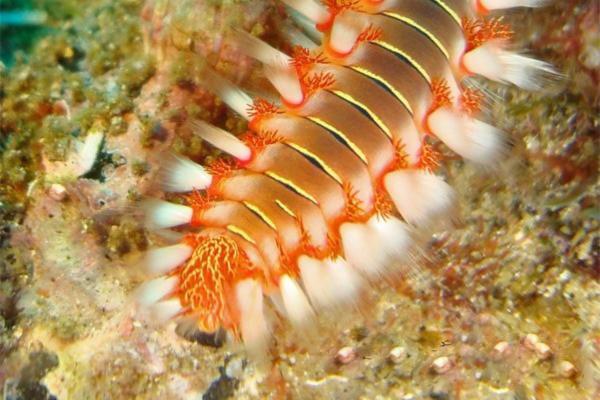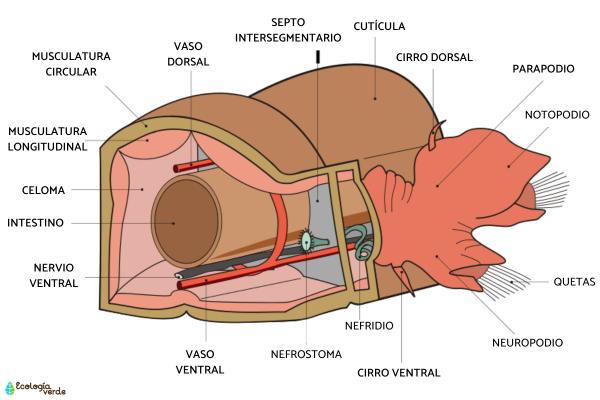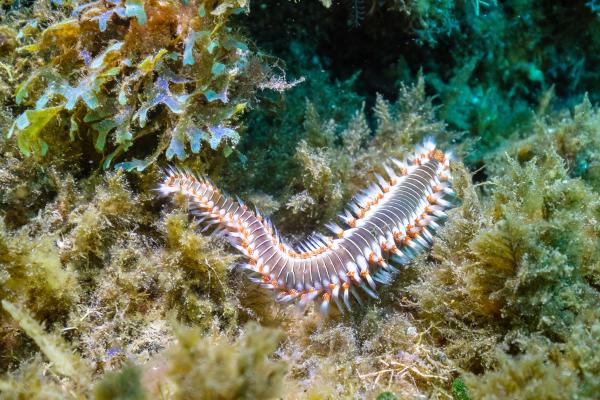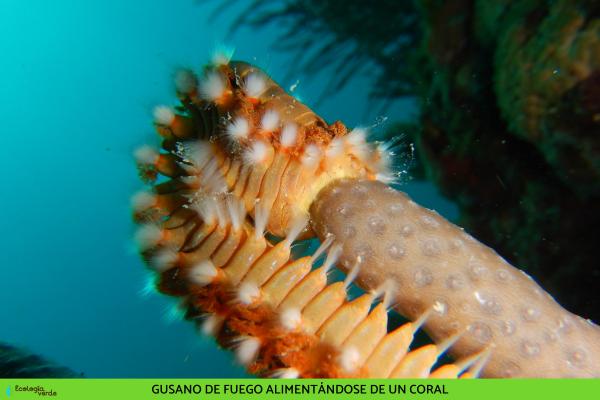Taxonomy: Phylum Annelida ➜ Class Polychaeta ➜ Order Amphinomida ➜ Family Amphinomidae
Common names: Fireworm, bearded fireworm, fire bristle worm
Size: Most individuals measure 4–10 cm in length, but giants up to 30 cm have been recorded; body width about 2 cm
Lifestyle: Nocturnal; usually solitary, though small feeding assemblies occur where prey is abundant
Warning display: Iridescent stripes in green, yellow, red, and white—classic aposematic “stay away” colours

| Structure | Description | Primary function |
|---|---|---|
| Segmented body | External and internal ring-like partitions (metameres) | Increases flexibility and burrowing ability |
| Parapodia | One paddle-shaped lobe per segment | Swimming, crawling, stirring sediment |
| Defensive chaetae | White, calcified bristles loaded with venom; detach at the lightest touch | Anchoring, locomotion, potent defence (burn-like sting) |
| Branchial tufts | Bright-red gill filaments alternating with white bristles | Gas exchange |
| Caruncle | Red chemosensory ridge on the head | Tracks prey and conspecific cues |
| Cuticle | Thin, protective outer layer | Shields against microbes and abrasion |
| Coelom | Liquid-filled body cavity | Works with muscle layers to power swift contractions |
Safety note
A bare-hand encounter can deliver hundreds of microscopic spines that cause intense burning and possible infection. If stung, gently lift out bristles with adhesive tape, immerse the area in hot (not scalding) water, and seek medical advice.
Geographic range
Tropical and subtropical Atlantic: Caribbean Sea, Gulf of Mexico, Ascension Island, Azores
Introduced or recorded in the Mediterranean and Red Sea (ballast-water dispersal likely)
Depth range
Intertidal crevices down to roughly 150 m
Typical micro-habitats
Coral-reef crevices—emerge at night to graze living coral tissue
Seagrass beds and sandy-mud bottoms—shelter and scavenge detritus
Under boulders and rubble—daytime refuge from predators and sunlight

Trophic role: Carnivorous with facultative scavenging
| Preferred prey | Occasional items | Feeding technique |
|---|---|---|
| Stony corals (scleractinians) | Small crustaceans, bivalves, shrimp, krill, tiny squid | Everts pharynx to suck soft tissues; a single meal lasts ~15 min |
| Soft corals, sea anemones | Carrion on the seafloor | Same suction feeding |
Dense fireworm outbreaks can decimate local coral colonies and hinder reef recovery.

Courtship cues: Females emit a green fluorescence a few days after the full moon; attracted males flash back.
Spawning: Both sexes ascend toward the surface and release gametes for external fertilisation.
Larval phase: Free-swimming planktonic stage settles to the benthos before metamorphosis.
Individuals may split; each fragment regenerates a missing head or tail thanks to metameric organisation.
This “clone by cutting” strategy fuels rapid population rebounds after disturbance.

Food-web regulation
As mid-level predators, fireworms influence abundance and composition of corals and other benthic invertebrates.
Sediment engineering
Their crawling and scavenging aerate seafloor sediments, recycle organic matter, and assist compaction.
Pollution sentinels
Sediment-dwelling habits mean they bioaccumulate heavy metals and persistent pollutants—useful indicators of marine contamination.
Changes in their abundance can flag ecosystem stress.
Hermodice carunculata is instantly recognisable by its blazing colours and venomous bristles. It is both a vital recycler in tropical Atlantic ecosystems and, when overabundant, a threat to coral health. Respecting this “underwater firebrand” helps divers avoid painful stings and reminds conservationists that even small invertebrates can act as barometers of a reef’s well-being.
Bibliography
Yáñez Rivera, B., Vallejo, S., Sergio, I., Arana, H., & Gillet, P. (2009). Taxonomy, trophic preferences, and symbionts of the fireworm Hermodice carunculata (Polychaeta: Amphinomidae) (No. TE/595.147 Y3).
Marine Bio Conservation Society (n.d.). Bearded fireworms. Available at: https://www.marinebio.org/species/bearded-fireworms/hermodice-carunculata/
University of the West Indies. (2016). Hermodice carunculata (Bearded Fireworm). Available at: https://sta.uwi.edu/fst/lifesciences/sites/default/files/lifesciences/documents/ogatt/Hermodice_carunculata%20-%20Bearded%20Fireworm.pdf
Rodríguez, V. F., & Mesa, M. H. L. (2015). Polychaetes (Annelida: Polychaeta) as biological indicators of marine pollution: cases in Colombia. Gestión y Ambiente, 18(1), 189–204.
animal tags: Fireworm
We created this article in conjunction with AI technology, then made sure it was fact-checked and edited by a Animals Top editor.